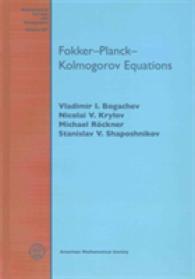- ホーム
- > 洋書
- > 英文書
- > History / World
Full Description
This volume examines perspectives on maritime and underwater cultural heritage (MUCH) in southern Africa and proposes new management approaches to advance protection and public engagement. By redefining the maritime historical narratives in countries that have predominantly interpreted their maritime past through colonial shipwrecks, it is possible to create an environment in which stakeholders become active participants in heritage management. The application of a broad maritime cultural landscape perspective that blurs the lines between the natural and cultural, tangible and intangible, and local and global binaries that are often applied to MUCH, results in a community-driven, relevant approach to heritage management. Appropriate management strategies are supported by balancing western based heritage values with alternative approaches to heritage conservation. Case studies illustrate the evolution and efficacy of this approach.
Contents
Contents
Preface
Introduction
Research Question
Relevance of the Study
Structure
Assumptions
1 Methodological Framework
1.1 Background to the Study
1.2 What is this Research About?
1.3 Methodological Framework
1.4 Research Methods
2 A Contemporary Framework for the Management of Maritime and Underwater Cultural Heritage
2.1 Introduction
2.2 The Development of Maritime Archaeology and Management Contexts
2.3 The Global Rules for the Management of Maritime and Underwater Cultural Heritage
2.4 National Legislative Frameworks: A South African Case Study
2.5 Why Does Nobody Care?
2.6 The State of Underwater Cultural Heritage in Sub-Saharan Africa
2.7 Conclusion
3 Building a Maritime and Underwater Cultural Heritage Management Laboratory
3.1 Introduction
3.2 The Foundation of a Heritage Management Laboratory
3.3 A Theoretical Interlude
4 Assessing the Status Quo of MUCH Management in Sub-Saharan Africa
4.1 Identifying Elements Affecting Approaches to MUCH Management
4.2 Using the Elements Matrix as a Tool to Assess MUCH Management Indicators
4.3 Assessing the Status Quo at Four Case Study Sites 93Balancing the Elements: Changing the Status Quo
5 Balancing the Elements: Changing the Status Quo
5.1 Introduction
5.2 Addressing Capacity Shortages and Relevance in South Africa: The Maritime Archaeology
Development Programme
5.3 Addressing Access and Presentation: Ilha de Mozambique
5.4 Addressing Authorisation and Rules: Eastern Cape Coast, South Africa
5.5 A Note on Lake Fundudzi
5.6 Observations and Analysis of Case Study Outcomes
6 The Evolution of a New Approach to Maritime and Underwater Cultural Heritage
Management in Sub-Saharan Africa
6.1 Introduction
6.2 Changing the Management Approach
Conclusion
Afterword
Appendix I Review of Legislation
Appendix II Element Decision Tables
Appendix III Lake Fundudzi Questionnaire
Appendix IV MADP Assessment
Appendix V Assessment of Salvage Activities (Arqueonautas)
Appendix VI MUCH Capacity in Sub-Saharan Africa
Bibliography
List of Figures and Tables
Abbreviations








